No one accepts a position at a company without knowing how much money they’d be making. Sales compensation is an important factor when attracting and retaining talent on your sales team.
You want to give the best talent a reason to accept a position on your sales team and stay with your company long-term. In this guide, I’ll discuss the importance of a sales compensation plan, the types of sales compensation plans, and the steps you can take to create one of your own.

Now, let's look at what a sales compensation plan is and why you need one.
The purpose of a sales compensation plan is to encourage positive behaviors across your team, set expectations and standards for compensation for all salespeople, and drive results to achieve overall team and organizational goals.
Creating a sales compensation plan has additional benefits.
Sales compensation plans create structure within the team.
Sales teams are known for their high turnover. The stresses of selling to uninterested prospects and the general lack of advancement opportunities can make even the most seasoned of salespeople hop from team to team.
One way to lower turnover is to create a sales compensation plan that adds structure to the team, differentiating between junior, mid-level, and senior reps. In doing so, you’ll communicate to the reps that there are advancement opportunities within the team, and they won’t feel like they should leave.
Sales compensation plans incentivize individual reps.
Knowing that they could earn more if they sell more will be enough to incentivize reps. Not only that but if you include additional benefits such as an educational stipend, your reps will be incentivized to seek additional training, making them more effective salespeople.
Sales compensation plans help you budget better.
By knowing how much you’ll pay each rep depending on their experience and performance, you can create budgets that better align with your company's financial standing. That way, you know how much of the company’s earnings will be allotted for your sales reps’ compensation. This will allow you to better prepare if the team underperforms one quarter.
The structure of a sales compensation plan varies by business and is typically based on team organization, resources, and goals. For example, one sales organization might offer a higher base salary, while another might prioritize commission based on their budget, business structure, employee needs, and team targets.
There should be a compensation plan for every member of the sales team based on their role, experience, length of the sales cycle, and the type of deals they engage in. Here are some other factors to consider while thinking about your sales compensation plan:
- What’s your budget?
- Does your company culture impact how you compensate employees?
- What’s your competition paying?
- What are living costs like in your area?
- What are your team‘s and organization’s goals?
Before I share how to create your compensation plan, let's take a look at some important sales compensation terms to know.
Sales Compensation Terms to Know
Depending on how you structure your sales compensation plan, the following terms and concepts may come up as you start the development process.
Sales Quota
A sales quota is a time-bound revenue target set by sales managers — either individually or as a group. The most common time constraints for quotas are monthly, quarterly, and annually. They can be measured as the sales managers and company leadership see fit, whether that's by profit, deals closed, or overall activity.
Sales Accelerators
A sales accelerator kicks in when one of your reps hits a specific amount over their quota. Quota attainment, number of products sold, and contract length are the most common types of sales accelerators. This type of payoff is exponential for your reps — they may end up with a huge commission check if they have a highly successful month or quarter (so be aware of your resources and budget). For example, if a rep hits 110% of their quota by the end of the month, you'd pay them 1.0x on their performance above 100%.
Sales Decelerators
Sales decelerators have the opposite effect as accelerators — they penalize underperforming reps. A decelerator may kick in between 40% and 60% of their quota. In other words, if a rep only hits 60% of their quota, their performance would be multiplied by a decimal (like 0.5) to calculate their compensation.
Clawbacks
A clawback kicks in when a customer churns (i.e., stop using your product or service) prior to hitting a specific benchmark. They cause the rep to lose their commission and are common among subscription companies in an effort to keep customer retention rates high.
On-Target Earnings
On-target earnings (OTE) provide salespeople with a realistic view into what their total compensation for a position would be when their expected and reasonable goals and quotas have been reached. Typically speaking, OTE would include the base salary and the realistic commission resulting from closed deals.
Sales Performance Incentive Fund or Sales Contests
Sales performance incentive funds (SPIFs) or sales contests are ways to incentivize high performance among your salespeople.
These tactics are often used to change behavior and include monetary (such as a $500 cash prize to the first rep who closes 10 deals of a certain product) or non-monetary (a nice dinner for every team that increases their retention rate by the benchmark percentage).
These sales incentives and contests should run for short periods of time — about one to four weeks total. If you run them any longer, reps will lose the necessary sense of urgency for this tactic to work.
Also, keep your sales contests limited. The more behaviors you reward, the likelier your team will be pulled into conflicting directions — making it difficult to drive specific outcomes.
Now, let's review a sales commission structure template and examples of different types of compensation plans.
Sales Compensation Structure Template
.png?width=320&height=415&name=Image%20Hackathon%20%E2%80%93%20Vertical%20(82).png)
Download the Free Template
Structuring your sales compensation plan is simple with this free template. In it, you'll find seven different types of comp plans that could work for your business. Each of them is made up of several factors that create the total compensation plan.
Base Salary: The compensation provided to a sales rep before they meet quota.
Projected Sales: The number of deals that the sales rep is expected to close by the end of the selling period.
Commission Rate: A commission amount expressed as a percentage of the revenue brought in by the sales rep.
Bonus Amount: The compensation provided above the base salary that compensates a sales rep for the deals they've closed during the selling period.
Commission Per Sale: The compensation amount paid to a sales rep per unit sold.
These are some of the most common sales compensation factors you'll take into account when developing your comp structure but may not use all of them in the same plan. Below are some examples of compensation plans and how each of these elements fit into them.
Sales Compensation Plan Examples
There’s no one specific way to pay employees in sales. Many companies tailor their plans according to how they conduct business. Generally speaking, there are four main types of compensation: hourly wages, salary, commission, and bonuses. Compensation plans are more detailed and can contain different forms of commission or no commission at all. They are all tailored to the size and scope of the business it applies to.
The following examples include the most common types of sales compensation plans. Each example has a different structure, so you'll be able to tailor your plan to your specific sales team and business based on your needs, resources, and goals.
1. Base Salary Plus Commission Plan

Create a custom version of this compensation plan in our free sales compensation calculator kit.
The most common sales compensation pay structure is the base salary plus commission plan. This structure provides reps with a fixed yearly base salary as well as commission. They get the security of a steady income with the economic incentive to sell.
This plan is ideal for most businesses because you benefit from greater clarity into your expenses (since there‘s less variability) and the opportunity to hire highly-motivated, competitive salespeople. Furthermore, since you’re giving reps a base salary, they're obligated to fulfill some non-selling tasks, such as training new team members.
In this plan, the commission percentage is lower because of the base salary. To determine your base-variable (or fixed) compensation split, think about the following factors:
- How difficult the sale is.
- How much autonomy is needed. (For example, are you providing your reps with leads or are you asking them to generate their own? Are you giving them technical support or none?)
- How much experience is necessary.
To determine the variable compensation, think about the following factors:
- How complex your sales cycle is.
- How much influence the rep has over the purchasing decision.
- How many leads reps work with at a given time.
- Your team's selling function (such as hunting or farming).
Essentially, the shorter and simpler a sale is and the less impact a rep has over the customer's behavior, the smaller the percentage of variable compensation should be.
One standard ratio across industries is 60:40 — meaning 60% fixed to 40% variable. A less aggressive ratio (think 70:30 or 75:25) is common when reps are required to teach the prospect because they're most likely selling a highly complex or technical product.
Account managers may have a similar ratio of fixed to variable pay, driving them to spend more time helping their existing customers than finding new ones.
Best for: Most businesses, as it provides greater clarity into expenses and allows for hiring highly-motivated, competitive salespeople while ensuring reps fulfill non-selling tasks.
2. Base Salary Plus Bonus Compensation Plan
A base salary plus a bonus compensation plan is common when your reps tend to consistently hit their pre-set targets. This approach offers a high level of predictability and still motivates your reps to close sales.
For example, you might pay $30,000 base and $15,000 for selling X amount per year. If you know about eight of your 10 employees will consistently hit quota, and total earnings are $55,000, you can set aside $440,000 in your annual budget for the bonuses. But again, this prevents reps from feeling any motivation to over-perform.
Best for: Companies with reps who consistently hit their pre-set targets. It offers a high level of predictability and motivation to close sales.
3. Commission Only Compensation Plan

Create a custom version of this compensation plan in our free sales compensation calculator kit.
A commission-only structure means you pay reps purely based on their performance. If they don't sell anything during a month, their salary is zero. If they sell $50,000 worth of product in a month, their salary may be anywhere between $15,000-$22,500, depending on the commission percentage you offer your employees.
Due to the simplicity of a commission-only compensation plan, you forgo a lot of risk — when your salespeople succeed, revenue increases; when they fail, you lose nothing.
It also motivates reps by giving them the freedom to earn as much money as they can while saving you time trying to identify any poor performers on your team. However, commission-only plans can make it challenging to forecast your expenses and stick to a tight budget.
In terms of the commission percentage to pay reps, you may decide it's anywhere between 5% to 45%, which is standard.
Additionally, the more support you expect reps to give customers (such as implementation help or account management), the higher their commission should be. Remember to factor in their level of involvement in the sale as well, meaning if they're only producing leads (rather than closing them, too), you should allocate a smaller commission.
Best for: Companies looking to minimize risk and motivate reps to earn as much as they can, while saving time identifying poor performers.
4. Gross Margin Commission Plan
Maybe your company will pay reps based on profit rather than sales. In other words, a rep would be compensated more for selling a product with a $2,500 gross margin than one with a $1,000 gross margin.
This works well because it discourages discounting. Reps can become reliant on discounts to close deals, which isn‘t good for your business. Not only are your margins eroded, but the perceived value of your product goes down and future customers will come to expect a price slash. Tying commission to the product’s final cost encourages reps to give fewer and smaller discounts.
Additionally, gross margin commission plans promote the sales of specific product lines. Not all of your products are created equal — whatever the case, paying on gross margin motivates your salespeople to sell more of your most profitable products.
However, there are three main things to keep in mind when it comes to gross margin commission plans.
-
Revenue must be your priority if you use this plan. Perhaps you're trying to build market share or attract the top 20 logos in your industry. You want salespeople to focus on those goals — compensating them on profit may distract them and cause them to pursue the wrong customers.
-
Reps must have control over pricing. Reps have to be either selling multiple products at different price points or have discounting power.
-
You must be able to track your gross margins. Shifting product and/ or distribution costs, rebates, and territory changes can make calculating this extremely hard.
Best for: Companies prioritizing revenue and looking to discourage discounting, promote specific product lines, and motivate salespeople to sell more profitable products.
5. Absolute Commission Plan
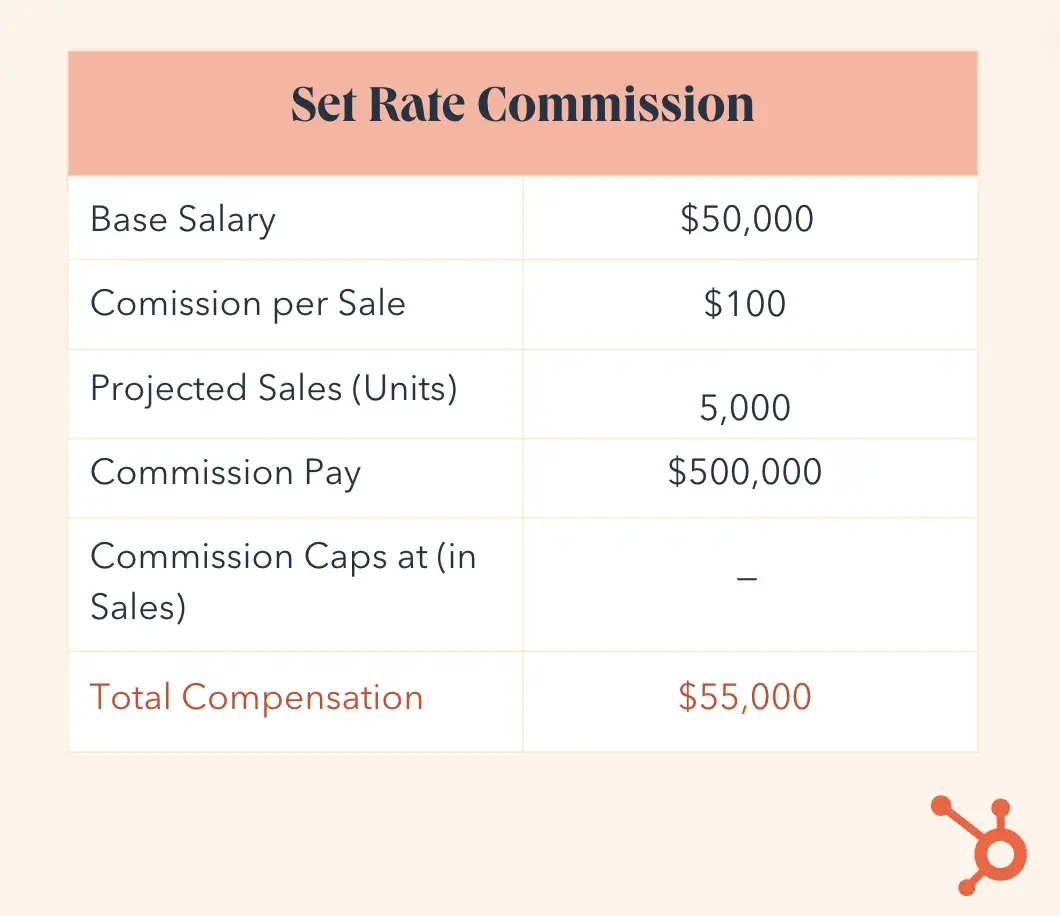
Create a custom version of this compensation plan in our free sales compensation calculator kit.
An absolute (or set rate) commission plan requires you to pay your reps when they reach specific targets or milestones. For example, you might pay your salespeople $1,000 for every new customer they obtain or 15% of upsell and cross-sell revenue.
These plans are easy for reps to grasp, which typically drives good results. And because the output is directly tied to salary, reps are usually highly motivated to perform. In addition, you don‘t have to set a quota — instead, you can set benchmarks or recommendations, but ultimately, you’re only compensating reps for what they sell.
However, this structure doesn‘t take into account market penetration or the number of opportunities. For example, one rep may be getting twice as many leads as their peer, but they’d both be treated equally.
Additionally, you‘ll need to carefully consider what’s best for the overall company when determining the commission. If you‘re trying to drive the sales of a certain product line, you’ll need to compensate reps accordingly (hint: reps will often do whatever is most lucrative for them, regardless of greater business objectives).
Best for: Companies aiming to drive good results with easy-to-grasp plans that directly tie output to salary, without setting quotas and instead focusing on benchmarks or recommendations.
6. Straight-Line Commission Plan
A straight-line commission plan rewards reps based on how much or little they sell. For example, if a rep reaches 86% of their quota, they'll receive 86% of their commission. If they reach 140% of quota, they receive 140% of their commission.
Although this approach is relatively easy to calculate, it‘s not perfect. So, what’s the issue? You want to encourage over-performance as much as possible. If you're already paying base, getting a rep to hit 140% of their quota from 120% has a greater financial impact than getting an under-performer to hit 100% of quota from 80%.
Plus, a rep may be just fine making 80% of quota — you don‘t want to disincentivize any of your reps to sell because they’re content with a lower salary (which is when you'd incorporate an accelerator).
Best for: Companies that want to encourage over-performance, as getting a rep to hit 140% of their quota from 120% has a greater financial impact than getting an under-performer to hit 100% of quota from 80%.
7. Relative Commission Plan
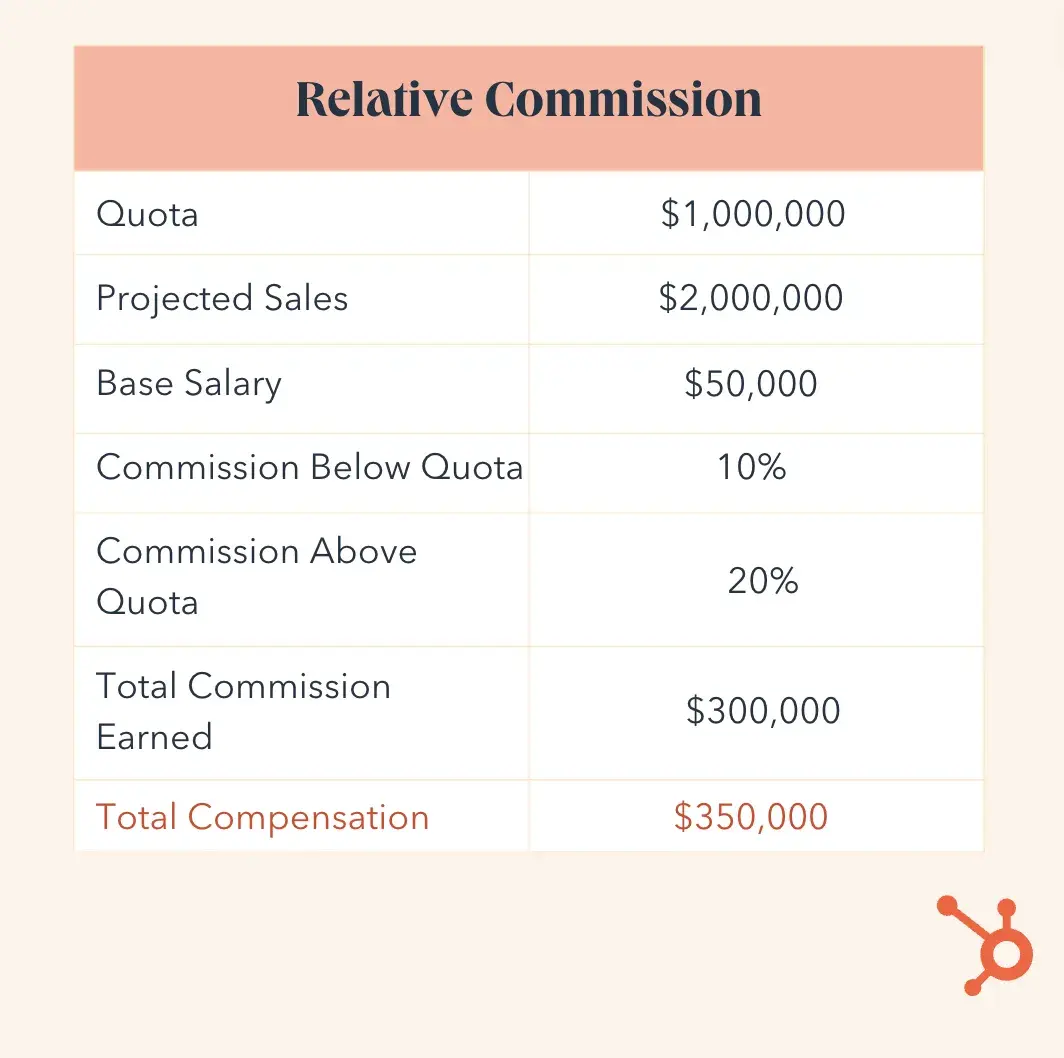
Create a custom version of this compensation plan in our free sales compensation calculator kit.
Unlike an absolute commission plan, a relative commission plan uses a quota or predetermined target. This target can be based on revenue (X dollars) or volume (X units).
When a rep hits 100% of quota, they make their OTE, which consists of either base salary plus commission or pure commission. For example, if a rep's yearly quota is $60,000, their at-plan commission is $50,000, and their base is $80,000, then their OTE would be $130,000.
Best for: Companies that want to use a quota or predetermined target based on revenue or volume, with reps making their on-target earnings (OTE) when hitting 100% of quota.
8. ‘Draw Against’ Commission Plan
Draw Against commission plans are regularly occurring payments made in advance to the sales rep, or subtracted from the rep’s total commissions. While it seemingly emulates salary schedule payments, they are regular commission payouts given to the employee before they need to earn that money back. If there are remaining commissions after a specific time period, you will payout the remainder.
There are two main Draw Against commission plans.
Recoverable Draws
Recoverable draw payouts are basically loans to employees that you expect to gain back from their earned sales commission. For example, if an employee draws $2,500 per month, they’re expected to earn a minimum $2,500 in commission each month so your business doesn’t lose money. If this threshold is not met, their debts roll over into next month’s pay period.
Nonrecoverable Draws
Typically suitable for newly beginning sales reps, this draw is a payment you will not expect to gain back. It is unlikely for these employees to earn much in commission from the start, so use this draw until their training period is over.
Best for: Companies looking to provide regular commission payouts to employees before they need to earn that money back.
9. Territory Volume Commission Plan
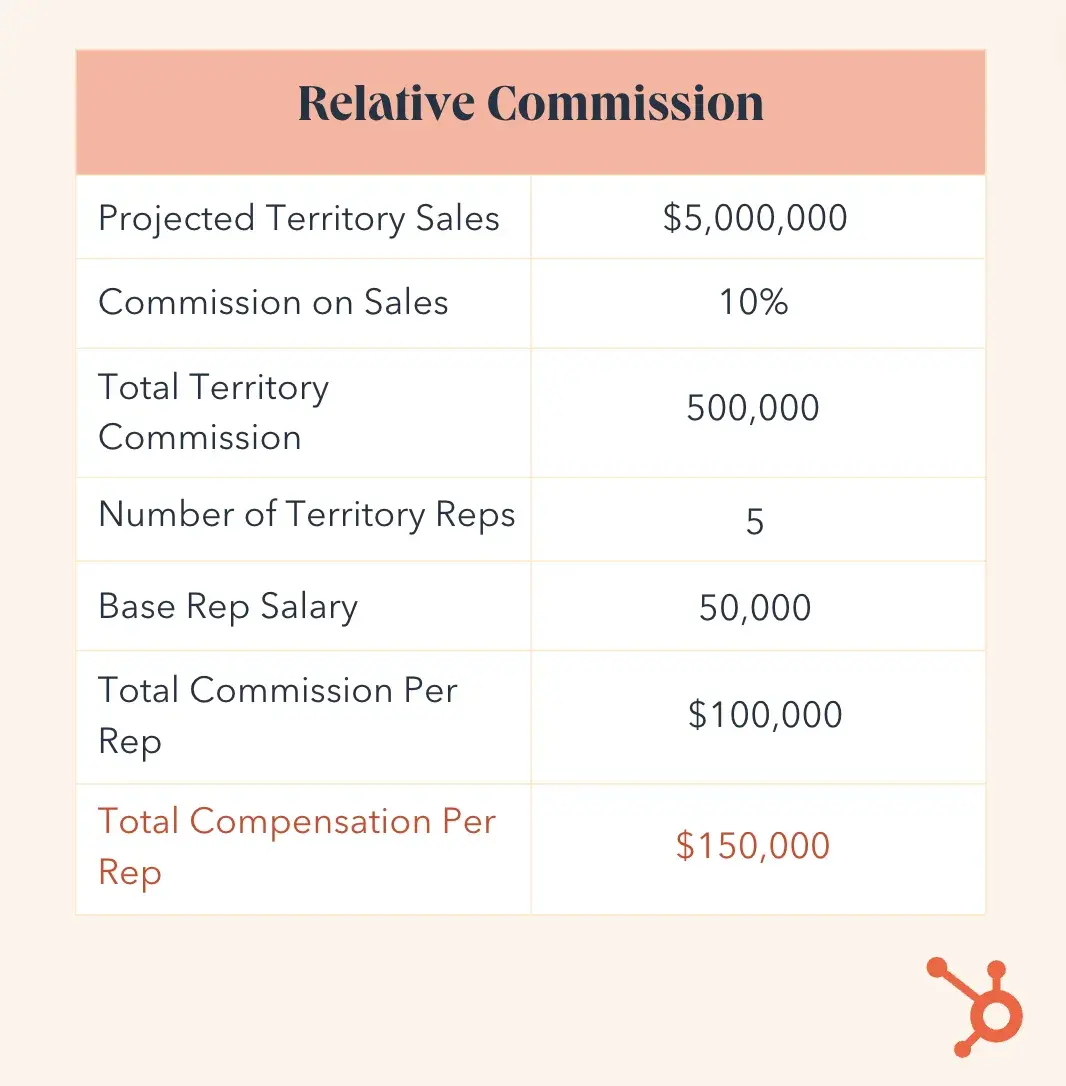
Create a custom version of this compensation plan in our free sales compensation calculator kit.
With a territory volume commission plan, sales teams work with prospects and clients in clearly defined regions. Your reps are paid on a territory-wide basis versus individual-sale basis. Once the compensation period is complete, the total sales are split among the reps who worked in that territory.
This type of compensation plan is a good fit for team-based sales organizations where each rep works towards a common goal and focuses on a specific territory or region. To attract reps to this type of plan and grow your sales teams, you may offer them an attractive commission paired with a well-developed territory.
Best for: Team-based sales organizations where each rep works towards a common goal and focuses on a specific territory or region, with commissions split among the reps working in that territory.
10. Salary Only Compensation Plan
With a salary-only structure, you decide ahead of time how much you‘ll pay your salespeople. It doesn’t matter how much (or how little) they sell, their take-home earnings are set.
A salary-only structure is fairly uncommon for sales teams. That‘s because, without commission, reps are usually less motivated to go above and beyond. After they’ve hit quota, they may relax instead of pushing for the next deal because there's no incentive or reason to continue onward.
Plus, many salespeople love the thrill of scoring commission — the high stakes and competitive nature of earning a commission is often part of the reason reps go into sales in the first place. Not to mention, your top-performing reps may just leave your company so they can make commissions elsewhere.
So, are there any positives to a salary-only compensation plan? They make it simple to calculate sales expenses and predict hiring needs. Additionally, your reps may be less stressed because they don't have to worry about the financial consequences of missing their target or the weight of the competition.
Best for: Companies that want to simplify calculating sales expenses and predict hiring needs, with reps potentially experiencing less stress due to not worrying about the financial consequences of missing targets or the weight of competition.
11. Multiplier Commission Plan
A multiplier commission plan incentivizes sales representatives to exceed their targets and drive revenue growth. You reward reps by multiplying their commission rate when they achieve a certain percentage above their sales target.
For example, if a rep's standard commission rate is 10% and they achieve 150% of their target, their commission rate might be multiplied by 1.5, resulting in a 15% commission on all sales over the target.
Say a rep has a monthly target of $50,000 and earns a base commission of 10%. If they sell $75,000 worth of products (150% of their target), their commission would be:
- 10% commission on the first $50,000 = $5,000
- 15% commission on the additional $25,000 = $3,750
- Total commission earned = $8,750
This plan encourages reps to push beyond their targets. The higher they go, the more they earn. It's an excellent option for companies looking to drive aggressive growth and reward top performers.
Best for: Industries with intense competition or high-growth startups. It’s also effective for product launches, seasonal sales, and expansion into new markets where companies want to establish their footprint quickly.
12. Milestone-Based Commission Plan
A milestone-based commission plan rewards sales representatives for achieving specific milestones throughout the sales process.
Instead of focusing on the final sale, this plan incentivizes reps to complete key activities that lead to successful deals — like setting up demos, securing contracts, or reaching revenue thresholds. Each milestone carries a specific commission amount or percentage.
For example, a milestone-based plan might offer:
- $500 commission for setting up a qualified demo.
- $1,000 for securing a signed contract.
- 5% commission on the first year's revenue once the deal closes.
This structure keeps reps focused on moving prospects through the pipeline and encourages them to prioritize high-value activities.
Let's say a rep sets up 10 qualified demos ($5,000), closes 5 contracts ($5,000), and generates $100,000 in first-year revenue ($5,000) in a quarter. Their total commission would be $15,000.
Best for: Industries with complex sales cycles, like B2B or financial services, where multiple touchpoints and milestones are required to close a deal.
Now, let's look at how to implement one of these types of sales compensation plans on your team.
There are dozens of potential approaches to and combinations of sales compensation strategies. To ensure you land on the best plan for your sales team, use a sales compensation planning template to calculate how much revenue you can expect and how much reps will be paid.
 Download Now for Free
Download Now for Free
2. Determine your sales compensation plan goals.
The first part of developing a sales compensation plan strategy includes setting your goals — laying out your business objectives is a critical part of any strategy.
So, here are some common primary and secondary goals of sales compensation plans for your consideration. Clarifying your priorities will help you decide how to compensate your salespeople in a way that works for your business.
Remember, your goals may be a mix of the examples below, or look completely different — your targets should be a reflection of what you hope to get out of the sales compensation plan and your unique needs.
| Primary goals of sales compensation plans |
Secondary goals of sales compensation plans |
| Grow revenue |
Lower expenses |
| Increase cash flow |
Drive sales for a specific product |
| Increase average contract length |
Attract target customers |
| Increase average deal size |
Reduce discounting frequency |
| Increase percentage of repeat customers |
Reduce average discount size |
| Increase retention rate |
Acquire seed accounts |
| Increase upsell or cross-sell rate |
Manage deal flow |
3. Choose a type of sales compensation plan.
Now that you have your goals, it‘s time to choose which compensation plan you’ll implement at your company. Refer back to the sales compensation plan examples to review the most common options.
While determining which plan is best for your business, ask yourself the following questions:
- What is my overall budget?
- How many reps do I have?
- What types of compensation plans do my competition use?
- What will my salespeople expect out of the plan implemented?
You‘ll also need to determine when you’ll provide the compensation for employees. There are four standard options for paying commissions.
When Customer Signs a Contract
Paying when the customer signs the contract is good motivation for the salesperson at hand because they immediately see the monetary impact of closing the deal.
However, this payment plan can also lead to cash flow problems if there‘s a significant delay between the signed agreement and the first payment (especially if you’re an early-stage business or it‘s a large deal that’s being closed).
When You Receive the Customer's First Payment
Compensating reps when you‘re paid is the most common payment method. There’s less lag between the time of the commission and revenue payments. You can also use clawbacks to incentivize salespeople to focus on good customer fit (rather than just anyone who will buy), which often boosts retention rates.
Note: If you‘re a subscription-based business, this timeline can disrupt your cash flow. After all, if you give a rep commission on the entire contract when you get the first check, you’re paying in advance of the customer's subsequent payments.
Every Time a Customer Pays
Paying each time you get an invoice is ideal if you want to protect your cash flow. Nonetheless, it can be complex to plan if you're on a tight budget, especially if you have a large sales team of reps closing and managing deals.
When Deal Goals are Reached
Also referred to as a tiered commission structure, this compensation plan is made to motivate reps and reward top performers that close a certain number of deals on a monthly basis. After reps exceed a predetermined benchmark, their commission rate increases. This model can also implement commission reduction for those that underperform.
4. Base your decisions on research and data.
Collect data on sales rep performance, customer visits, and segmentation using a tool like HubSpot Sales Hub to identify areas where your team's efforts may not align with your priorities.
Josh Miller, Head of Sales Compensation at CVS Health, adds why this is important in gaining trust in The Sales Compensation Show:
"If you can show that this isn't hypothetical, this is somebody that already happened over here, we designed this is what resulted, this was not what we were looking for.
And the following consequences occurred, that can open up the eyes of the person to realize that you‘re not throwing out something that has a 1% chance of happening, you’re throwing out something that has a 60 to 70% chance of happening."
Using this information builds credibility and support for your compensation plan revamp. For example, analyzing the volume of activity and customer visits relative to different customer segments reveals misalignments between your sales team‘s efforts and the areas you’ve described as most important.
Also, create a framework to collect feedback on individual sales rep performance. Sales compensation professionals have visibility across all organizations and teams, allowing them to identify top performers based on the deals they close and the feedback they receive. Compare this information to current compensation rankings to uncover discrepancies you need to address in your plan design.
5. Prioritize simplicity in sales compensation plans.
Keeping sales compensation plans simple is crucial — but it’s especially important for large organizations. At HubSpot, even with 8,000 employees, we keep commission plans straightforward for sales representatives. This is in line with industry best practices since 86% of companies standardize their compensation plans.
Kat Walenty, a senior manager at HubSpot, underscores the importance of this simplicity in a podcast:
“There‘s a lot of nuances around the other things, the benefits that go with it, how we’re paying against market, finance, like, what are we looking to stiff on? There's just a lot more to it,” Walenty says. “Whereas, maybe we go to the reps with a very simple plan, but, all of the other things around it and getting there are the things that make it very complex and complicated.”
The larger the organization grows, the more variables come into play, making sales compensation an increasingly complex optimization problem.
Trying to incentivize every behavior can lead to incentivizing none, so it's essential to find the right balance within teams and segments.
For example, your sales compensation plan could consist of a base salary and a commission rate of 10% on all sales. Set a clear quota for each representative based on their territory and experience level. If a representative achieves their quota, they earn their full commission. If they exceed their quota, they earn an additional 5% commission on the excess amount.
Prioritizing simplicity in the front-facing aspects of the plan helps keep sales representatives focused and motivated.
6. Choose a payroll software.
Once you've determined your plan goals, type, and payment plan, you can choose a payroll software to assist in compensating your salespeople.
Depending on how long your company has been established and whether or not you have an HR team that handles pay and benefits, you may or may not already have payroll software. If you do, it should be easy for you to incorporate your new sales compensation plan into the software.
If not, you might consider one of the following three popular payroll software options to help you carry out your plan.
-
Gusto: This software offers an all-in-one service, which includes payroll, HR, and benefits so you can handle all payment-related work from a central location.
-
Intuit QuickBooks Payroll: With automatic payroll tax calculations, paycheck accuracy, and native payroll integration for your accounting software, this option will allow you to focus your time and attention on other important tasks you need to manage.
-
Patriot Software Payroll: Patriot is a great option for anyone with a low budget who needs the bare minimum payroll-related features and capabilities.
-
Xoxoday Compass: Xoxoday has a ton of different integrations that work well with your existing ERP, CRM, HRMS, HCM, Spreadsheets, or any sales tech stack to centralize and manage all your commission data in one place.
-
Incfile's Employer Tax Calculator: While not strictly software, this employer payroll tax calculator tool can estimate tax deductions and withholdings. Incfile’s tool can also estimate hiring costs, pay employees accurately and on time, and better manage temporary and/or seasonal employee payroll.
7. Set quotas and expectations for compensation.
Now it‘s time to set your quotas for your individual reps and/ or your team as a whole. This will allow you to establish expectations for compensation with your salespeople so everyone knows what’s expected of them and how they're going to have the opportunity to make money.
Of course, this begs the question: How do you decide what quota should be? There are two main approaches to setting quotas.
Bottoms-Up Approach
The bottoms-up approach requires you to consider your team‘s capabilities as well as the perceived market opportunity to determine what each territory’s or salesperson's quota should be. The more data you have here, the easier this will be.
Your inputs will vary depending on your product and type of sale, but generally, you'll want to consider the following when using the bottoms-up approach to establish quota:
- Average contract value (ACV) or average deal size
- Average revenue per salesperson
- Number of salespeople
- Number of qualified leads (per month or quarter)
- Percentage of qualified leads that close
These considerations will tell you how many deals a rep should be working and, thus, what a reasonable quota should be.
Alternatively, you can simply multiply the typical number of closed deals by the average deal size. This will give you a baseline number to use for your quota.
But beware — the more successful and experienced your salespeople become, the more deals they‘ll be able to work and the bigger their contracts will be. This means their quota may quickly become inaccurate, so you’ll want to consistently evaluate it if you go with this approach.
Top-Down Approach
With a top-down approach, you combine market data with your revenue targets to figure out what your team needs to bring in.
So, if most companies in your space pay their salespeople in the X to Y range, and your reps need to close Y amount in total for your business to hit the established goal, you can determine a reasonable OTE as well as your optimal team size.
8. Maintain your sales compensation plan.
As your business goals evolve, teams grow, product line changes, and competition adjusts over time, your compensation plan will need to be revisited. Like any business strategy, it's not going to stay relevant forever — what works now might not suit any of your needs a year from now.
Review and analyze your compensation plan to keep your reps happy and motivated. At the same time, don’t revise your compensation too frequently. Research suggests that confidence drops when comp plans are changed frequently. It shows you aren’t confident in the plan.
Ensure you're implementing a plan that helps you positively impact your business's bottom line. Build it right the first time and stick with it unless there are significant changes that require revisions.
Sales Bonus Structure
Many companies offer bonuses to sales reps based on certain criteria to encourage business growth, customer retention, or employee satisfaction.
If you‘re confused, here’s a quick disclaimer on how sales bonuses and sales commission differ: Sales reps earn commission based on the volume of units sold, or the revenue obtained from a new customer. For instance, perhaps a sales rep earns 5% commission on every $1 sold. (It's important to note: Commission is one type of bonus that you can offer.)
A sales bonus, on the other hand, can be tied to revenue (for instance, maybe your sales reps receive a $10,000 bonus for every $100,000 worth of revenue they bring into the company), but it doesn't have to be.
Sales bonuses can be tied to other achievements as well, such as if a sales rep increases a customer's lifetime value, or if a sales rep has worked at your company for five years.
In 2022, the most popular formula calculation method was a bonus formula tied to quota performance.
There are different ways to structure your bonus structure. These include:
-
Variable bonus: Your sales rep earns a certain bonus (or commission) for a certain amount of revenue obtained, or when they reach a certain pre-identified achievement.
-
Above-plan incentive (also known as SPIFs): Your sales rep earns a bonus when they meet certain criteria for a specific product or service.
To explore these two bonus options more in-depth, let's take a look at some bonus examples.
Sales Bonus Examples
1. Bonus Off Commission (Variable Bonus)
In this first example, a sales rep will earn a bonus based purely on the amount of revenue they bring into the company. If a sales rep makes a $100,000 deal, they might earn $10,000.
Alternatively, perhaps you give commission based on units sold. If a sales rep makes 10 deals in one month, they might receive a $1,000 bonus.
2. Bonus Off Customer Lifetime Retention (Variable Bonus)
If your goal is to reduce customer churn, you might want to motivate your sales reps to increase customer lifetime value through up-selling or cross-selling to existing customers. One way to do this is by offering bonuses for customer lifetime retention.
For instance, perhaps you award your sales reps a bonus of $5,000 for every customer who signs a 3-year contract and $10,000 for every customer who signs a 5-year contract.
3. Bonus Off Annual Performance (Variable Bonus)
This type of bonus awards employees who've gone above and beyond for the business over the past year.
An example of this would be a bonus given to each sales rep who reached 120% of quota over the past year.
4. Bonus Off Sales for Specific Product or Service (Above-Plan Incentive)
If you've just launched a new product, it could be a good opportunity to offer SPIFs to your sales reps.
SPIFs have pre-defined time frames and criteria. For example, perhaps your sales reps earn $500 each time they sell your new product to a customer. Alternatively, maybe every sales rep who sells 100 units of your new product receives a $1,000 gift card.
SPIFs typically only last for a short period of time. For instance, you might encourage a quick burst of sales on a new product by offering SPIFs to your sales rep for six months.
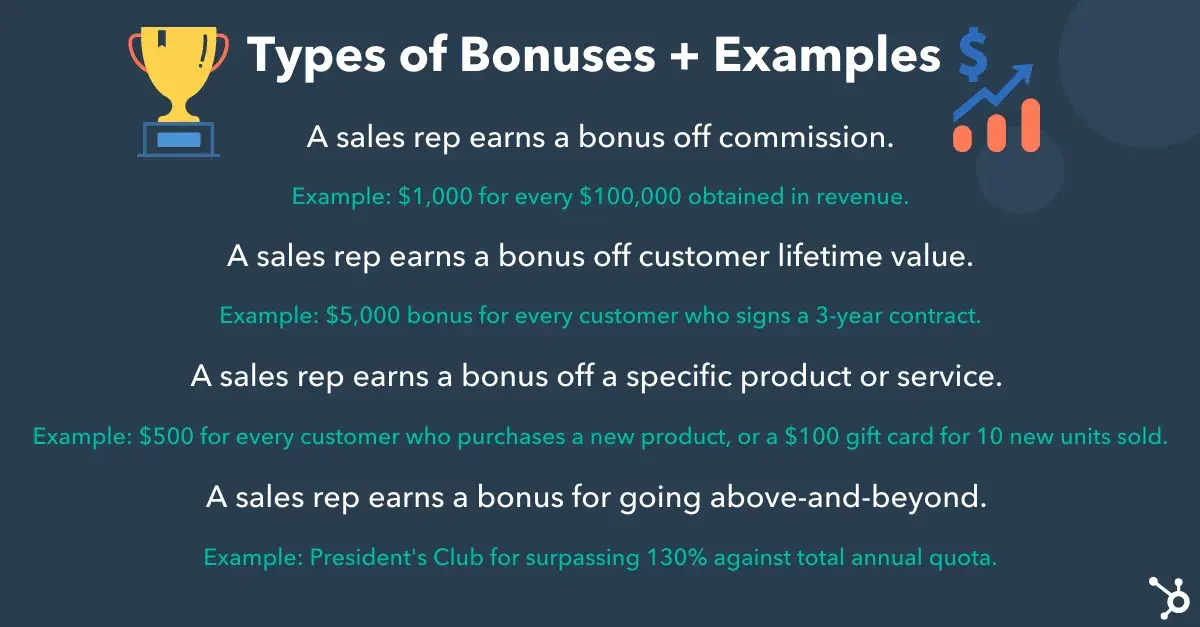
Begin Creating Your Compensation Plan
Remember, no sales compensation plan is perfect — your priorities are constantly shifting, your reps are always looking for new loopholes, and your prospects are periodically changing their preferences.
Follow the tips above and develop a sales compensation strategy to fit your specific business needs and resources to help drive your bottom-line success.
This post was originally published in July 2020 and has been updated for comprehensiveness.
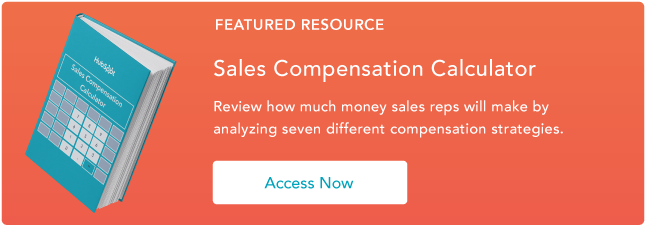


 That's where Voss, the former hostage negotiator, comes in. As he explains it, AI and other technologies have created the Jetsons-like world that we now live in. But emotionally and psychologically, people are still in the Fred Flintstone era. Business leaders can use technology to get sales leads, but they still need to know how to relate to and interact with other human beings.
That's where Voss, the former hostage negotiator, comes in. As he explains it, AI and other technologies have created the Jetsons-like world that we now live in. But emotionally and psychologically, people are still in the Fred Flintstone era. Business leaders can use technology to get sales leads, but they still need to know how to relate to and interact with other human beings. 























































 If you’re involved in complex, lengthy and high-value B2B sales environments, you can’t afford to regard opportunity qualification as a one-off exercise. You need to think of it as an ongoing process, in which you continually accumulate new learning as well as regularly revalidating any previous assumptions.
If you’re involved in complex, lengthy and high-value B2B sales environments, you can’t afford to regard opportunity qualification as a one-off exercise. You need to think of it as an ongoing process, in which you continually accumulate new learning as well as regularly revalidating any previous assumptions. Bob Apollo
Bob Apollo









.png?width=320&height=415&name=Image%20Hackathon%20%E2%80%93%20Vertical%20(82).png)





 Download Now for Free
Download Now for Free







 Born out of a frustration with recruiting within the peninsula-trapped City of San Francisco, Terminal is a platform allowing companies to tap into talent abroad. Starting with campuses in Kitchener-Waterloo, Montreal and Vancouver, the startup aims to plant physical flags in as many of the world’s global talent centers as possible. Terminal is being run by…
Born out of a frustration with recruiting within the peninsula-trapped City of San Francisco, Terminal is a platform allowing companies to tap into talent abroad. Starting with campuses in Kitchener-Waterloo, Montreal and Vancouver, the startup aims to plant physical flags in as many of the world’s global talent centers as possible. Terminal is being run by… 





